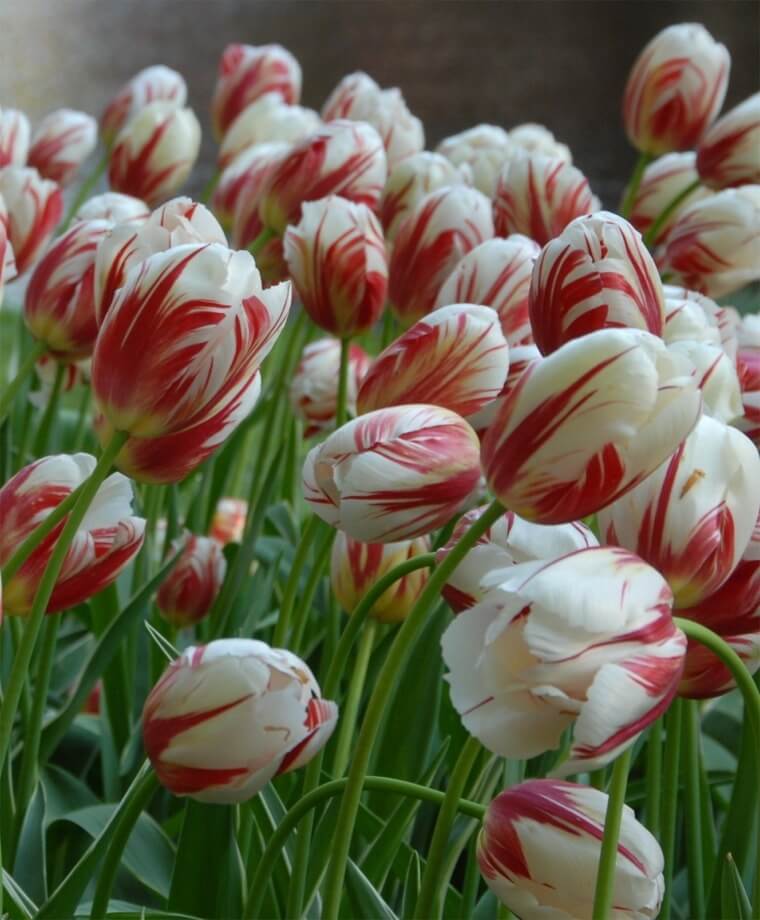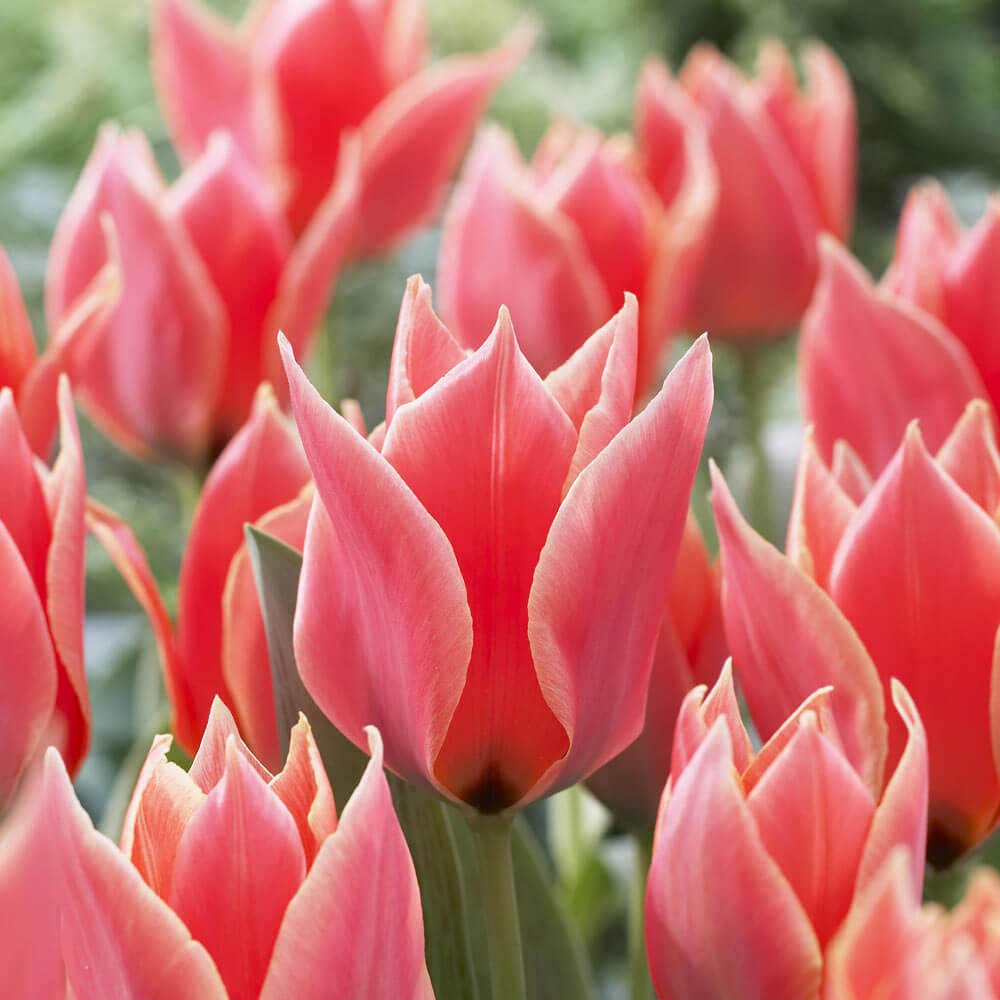Tulip flowers belong to the Lily family blooming in spring from energy-storing bulbs. After flowering in spring, Tulips become dormant in summer when flower-stock and leaves die. In spring the following year, Tulip flower emerges as shoot from an underground bulb. Since the 10th century, Tulips were grown in Persia. Later, it was grown in lands stretching from South Europe to Central Asia. Since the 17th century, Tulips have been cultivated in mostly mountainous areas with a temperate climate. Tulip flowers are large, brightly colored and attractive. Tulip flowers make popular ornamental garden plants and cut flowers worldwide. Over the decades, thousands of hybrids have been produced using the horticultural cross-breeding process. Here are 12 different types of Tulip flowers to grow in your homes.
{ 1 } Single Bloom Tulip Flowers

Single bloom Tulip flower opens slightly resembling a traditional Persian “turban”. As a result, it got its name Tulip (Tulip) meaning “turban” in Persian. Every petal emerges out from a single point of the shoot. The petals are bi-colored in well-blended pink and orange. Most of the color of the petal is pink. The orange coloring is where two petals meet each other.
{ 2 } Beautiful Double Bloom Tulips

Beautiful double bloom tulips have several layers of petals. Each petal is held together at a single point by a stout green shoot. The double bloom Tulips resembles an opened Rose (Rosa) rather than a Persian “turban” or single Tulip. Each petal has two colors – Violet on the inside and Lilac on the outside. These beautiful blooms look amazing as garden plants with their big flowers!
{ 3 } Rainbow Colors in Parrot Tulips

As the name suggests, Rainbow Colors in Parrot Tulips has all the hues of the rainbow. The petals are shaped resembling the Parrot’s beak. Stout red shoots hold the Tulip flowers together. Every petal emerging out from the single point of the shoot curves inwards on the sides. Each petal has a prominent mid-vein that helps shape the Tulips yet
{ 4 } Ornamental Look With Fringed Tulips

Stout green-colored shoots hold the fringed Tulip flowers together. These unusual-looking Tulips resemble a single bloom Tulip. Every petal emerging from the single point has shades of pink color that lightens on top. Also, portions, where two petals meet, are white-colored along with white fringes. These make Tulips especially unique. These Tulips make excellent ornament garden plants.
{ 5 } Bi-Color Standard Tulip Bulbs

Bi-Color Standard Tulip Bulbs resemble the single bloom Tulips shaped like Persian turbans. Stout green-colored shoots hold the tulip flowers together. Every petal emerging out from the single point is mostly white with purple patterns. The mid-section of the petal and the section where two petals meet mostly have the patterns. In the mid-section, the design is lengthwise while at the joints the design is cross-wise.
{ 6 } Famous Rembrandt Tulip Flowers

Famous Rembrandt Tulip Flowers got their name their association with the Dutch Golden Age paintings. In the 17th century, the Netherlands grew Tulip flowers when there was Tulip mania. Around that time, a virus affected the Tulip bulbs and led to variegated patterns in the blooms. People admired and valued those Tulip flowers. There are no broken Tulips available today but, the closest Tulip group is known as Rembrandts. These Tulips got their name due to Rembrandt’s famous paintings of those Tulip flowers. They resemble single bloom Tulips and have bi-colored (white and dark pink) petals. Some Tulip flowers are whiter than others that are more dark pink. Typically, the base of the petals has a dark pink color.
{ 7 } Fosteriana Tulip Flaming Purissima

A stout green-colored shoot holds the Fosteriana Tulip Flaming Purissima flower together. The Tulip Flower opens up at the top more than the single bloom Tulip. The petals of these Tulip flowers range from white, light pink to dark pink colors. The pink petals have white and yellow colors and vice versa.
{ 8 } Greigii Calypso Tulip Flowers

Greigii Calypso Tulip Blooms have petals arranged very differently from single bloom Tulip. The petals of Greigi calypso blooms have a different shape than the commonly seen Tulip flowers. These petals are narrower at the base and tip than the wide middle section. A stout green-colored shoot holds the tulip flower together. From its single point, four pinkish orange-colored petals emerge leaving a small space in between. Identical colored and shaped inner petals emerge to fill the open space. These petals have a triangular dark brown colored blotch at the base where it meets the shoot.
{ 9 } Viridiflora Tulip Blossoms

Viridiflora Tulip Blossoms resemble double bloom Tulips except that these flowers do not open in layers. A stout green-colored shoot holds the tulip flower together. From a single point, every petal of the Tulip flower emerges. The petals are broad at the base and middle-section but, tapers at the tip. Each petal has shades of pink, white, yellow and light green colors. The designs on the petals differ from one another making each Tulip flower unique and special.
{ 10 } Pretty Lily Flowering Tulips

As the name suggests, the pretty Lily flowering Tulips resemble the Lily family. A stout green-colored shoot holds the tulip flower together. From its single point, the petals emerging are white with pink on the edges. Top edges of petals curve outward as in case of flowers of the Lily family is pretty blooms have six petals. A stout green-colored shoot holds them together at a single point. Every cream-colored petal has a yellowish blotch at the base where it meets the shoot. Alternate petals have crimson patterns running lengthwise.
{ 11 } Kaufmanniana Tulips In Pretty Blooms

Kaufmanniana Tulips in pretty blooms have six petals. Its stout green shoot holds the petals together at a single point. Every cream-colored petal has a yellowish blotch at the base where it meets the shoot. Alternate petals have crimson patterns running lengthwise.
{ 12 } Darwin Hybrid Tulip Flowers

Darwin Hybrid Tulip Flowers are the popular brightly colored Tulip flowers. These are available in bright yellow, pink and red. The crossbreed process produces bi-colored petals including yellow-and-red, and red-and-pink.





